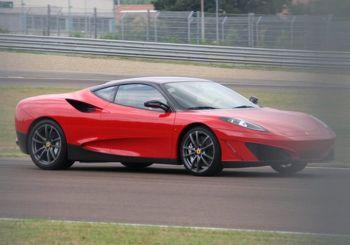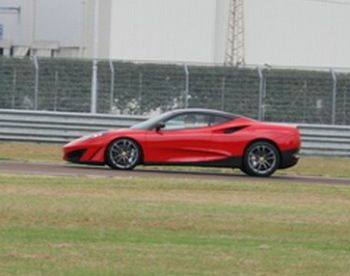

 |
|
The rebirth of coachbuilt Ferraris takes
another step as a one-off rebodied F430
Coupé created by Fioravanti exclusively for
a collector breaks cover revealing sleek and
dynamic lines in the Italian design house'
finest traditions. |
|
|
|
A shock sighting at Maranello has caused quite a stir amongst Italian car
enthusiasts, with the emergence of a trio of photographs depicting a Ferrari 430
based sportscar. Passing visitors can expect to sight the odd “Muletto” on the streets in
the vicinity of the factory, and if quick enough may occasionally manage to snap
a photograph or two. However, Ferrari have a strict rule when it comes to keeping undercover design
details secret.
It thus came as a surprise to the photographer, when this
completely undisguised sports car was spotted prowling within the factory
boundaries and on the Fiorano test track. Not to be mistaken for one of the F430 successor's prototypes, which
remain clad in thick dark plastic, this car is a product of the latest coachbuilding programme launched by Ferrari with the
official rights being extended to a handful of companies.
Maranello's embracing of the historic coachbuilding
tradition follows the widespread acceptance of several
recent one-off works such as Pininfarina's P4/5, Giugiaro's
GG50 and Zagato's 575 GTZ.
With a cheque-book capable of covering two million Euros, and a design idea,
Ferrari will offer the client the choice of three cars, the F430, 612 Scaglietti
and Enzo, as a starting point, from which a unique “speciale” can be
created. Certain hard points must remain, however, including the front
windscreen and the fundamental crumple zone structure. In the case of the car
pictured, the well designed original F430 lighting units have also been
retained.
Whereas Pininfarina
lent their hand and experience with the design of the
original F430, this special Prancing Horse design closely bears the signature
of the Fioravanti design house, a company now celebrating its 20th
anniversary. The design of the side profile is typical of Fioravanti, with the
use of sleek and dynamic sweeping lines, extending from the front bumper to the
rear of the car. Simultaneously, the lines divide the aluminium coachwork into
separate planes, which in turn have been fashioned to create a high degree of
sculpture.
In comparison to the heavily detailed front end, which has been relatively
lightly modified from the base F430, the rear of this one-off remains refined.
Single circular lighting units, sourced from the Ferrari 599, have been
installed on either side of the mesh cooling grille, creating an understated
elegance. Meanwhile, in harmony with the fluid form language, shallow flying
buttresses have been added, a design element accredited to Pininfarina.
Perhaps the bravest feature of the coachwork
of this car, which is destined for an Asian collector, lies in the application of carbon
fibre as a finish for the side skirts, mirrors, roof, and front lower spoiler.
Weight saving was clearly one of the goals of the project creator. It is
probable that the interior will continue the carbon fibre theme further. From an
engineering perspective, the engine cooling has been improved through the presence of large vents located in the rear wheel
arches, although Ferrari stipulates that the drivetrain must
remain unaltered.
Photos
courtesy of
Autoblog.nl
|